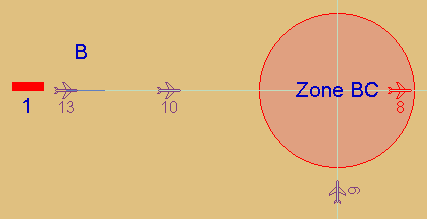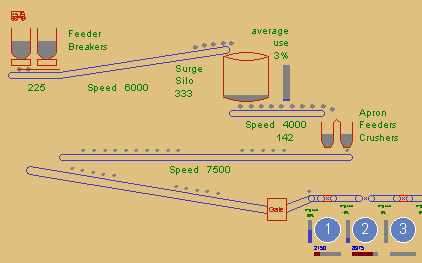 |
You can use Proof to animate many different kinds of systems |
|
|
Example - A Hypothetical Air Traffic Control Zone
 This animation depicts the operation of a
hypothetical aircraft traffic control zone. The most important rule in the
operation of this system is that no more than one airplane can be in the
circular control zone at any given time.
This animation depicts the operation of a
hypothetical aircraft traffic control zone. The most important rule in the
operation of this system is that no more than one airplane can be in the
circular control zone at any given time.
Proof has been used to depict air traffic control situations not only of this simple, microscopic form, but of the entire U.S. airspace. Proof has the horsepower to smoothly and simultaneously move over 5,000 objects across complex drawings such as a map of the United States. The simple layout over which the airplanes are moving was drawn using Proof's CAD-like drawing tools, as was the icon used to depict the airplanes.
In large-scale animations, layouts are often imported from CAD files or other file-based geometric data.
Example - A Mining Application
 This animation depicts the operation of an open pit mine. What's interesting
about the animation is that it depicts an essentially continuous flow of
material by using a combination of icons and bar graphs.
This animation depicts the operation of an open pit mine. What's interesting
about the animation is that it depicts an essentially continuous flow of
material by using a combination of icons and bar graphs.
The height of the silos is animated using bar graphs. The model that produced this animation issues "Set Bar Rate" commands each time the rate of flow into or out of a silo changes.
The flow of material along conveyors is represented by discrete icons. The conveyors are animated as Proof circular paths. For such paths, when an object on the path reaches the end of the path, it automatically goes back to the beginning. In this animation, the paths representing conveyors correspond to the top surfaces of the conveyors, but not the bottom surfaces. Thus, when an object (icon) reaches the end of the top of a conveyor, the same object reappears at the beginning of the top of the conveyor. In the absence of any further user-issued commands, objects placed on such paths cycle endlessly.
The paths representing the top two conveyors have downward curved portions that extend slightly beyond the ends of the conveyors. This gives the realistic impression of material flying off the conveyors.
Comparing the Two Examples Above
The air traffic control system is an example of a system that is easy to animate. Why? Because the relationship between what's moving in the system and what needs to move on the screen is 1-to-1. This is very common in animations of vehicular traffic, people flow, manufacturing, and material handling. (Such applications were among the first to be animated.)
In the mining example, the relationship between what's moving in the system (a continuous flow) and what needs to move on the screen (icons) is not a simple 1-to-1 relationship. This property is fairly common. For example, in animations of telecommunication systems, we can't animate the flow of individual packets of information, because there are too many of them, and they move too fast. Instead, we can use bar graphs or colors to connote traffic intensity, or we can aggregate packets into animation "blobs." For example, one blob might represent 10,000 packets an travel at 1/10,000 of normal packet speed.
As far as Proof is concerned, there's no difference between the two systems. It simply moves icons across drawings and updates bar graphs and textual displays in accordance with user-issued commands. It's up to the Proof user to decide how best to exploit the visual medium Proof provides.